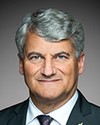Thank you, Mr. Chair.
Ladies and gentlemen of the committee, thank you for the invitation to appear and discuss our April 2017 economic and fiscal outlook. Today I am joined by Mostafa Askari, the assistant parliamentary budget officer, as well as Jason Jacques, Chris Matier, Tim Scholz and Trevor Shaw. They will be pleased to answer any questions you have regarding our outlook or other PBO analysis.
With regard to the economic outlook, on balance our outlook for real GDP growth in Canada is essentially unchanged from October. Although the Canadian economy outperformed our forecast in the second half of 2016 and the first quarter of the year, we expect growth in consumer spending to moderate and residential investment to decline in the second half of 2017 and through 2018. We project real GDP to grow on average at 2% annually from 2017 to 2021.
Our projection for the growth in nominal GDP, which is the broadest single measure of the tax base, is on average 4.1% annually over 2017 to 2021, the same as in our October outlook. Adjusted for historical revisions, the level of nominal GDP is on average $10 billion higher per year over the period of 2017 to 2021. This is due to stronger than anticipated nominal GDP growth in the second half of 2016. We have also revised upward our outlook for long-term interest rates, reflecting higher than anticipated long-term rates in the United States.
With regard to the fiscal outlook, based on financial data through the first 10 months of 2016-17, we expect the budgetary deficit to be $20.7 billion, or 1% of GDP, in 2016-17. This is $1.6 billion lower than we projected in October. For fiscal years 2017-18 to 2021-22, we are projecting budgetary deficits that are $2.2 billion larger on average compared to our October outlook. This is primarily due to higher spending resulting from new policy decisions and higher long-term interest rates.
In budget 2016, the government committed to reducing the federal debt-to-GDP ratio to a lower lever over a five-year period ending in 2020-21. This translates into a fiscal target of 31% or lower for the federal debt-to-GDP ratio in 2020-21. Under current tax and spending plans, we project that the federal debt-to-GDP ratio will be 29.6% in 2020-21, which is 1.4 percentage GDP points lower than the government's target.
Given the possible scenarios surrounding our economic outlook, and on a status quo basis, it is unlikely that the budget will be balanced, or in a surplus position, over the medium term. However, it is likely that the federal debt-to-GDP ratio will fall below its current level of 31% over the period from 2017-18 to 2021-22. We estimate that there is, approximately, a 67% chance that the federal debt-to-GDP ratio will be below its targeted level in 2020-21.
With regard to budget 2017, our report also identifies some key issues for parliamentarians.
On the economic fiscal outlook, the PBO projects budgetary deficits that are $5.9 billion lower, on average, than budget 2017 does for 2016-17 to 2021-22. This reflects the government’s $3 billion annual risk adjustment and PBO’s stronger economic outlook. The PBO believes that the government’s outlook for the budgetary balance is overly prudent over the period 2017-21. This results from the use of an outdated economic outlook that goes back to December and from incorporating a risk adjustment.
On federal infrastructure spending, the data indicate that federal spending on infrastructure has lagged the timing set out in budget 2016. We expect that roughly half of the $4 billion in infrastructure funding in 2016-17 will be spent as planned in budget 2016. The PBO expects that spending will pick up in 2017-18 to above the level projected in budget 2016, resulting in overall infrastructure spending of $10.1 billion over two years, which is close to 90% of the originally projected levels.
As to operating expenses, budget 2017 provides for 1% in annual growth over the medium term. Yet collective agreements promise annual wage growth exceeding this amount. Parliamentarians may therefore wish to seek further detail on the government's strategy to manage operating expenses.
My colleagues and I would be happy to answer any questions you may have regarding the economic and fiscal outlook.
Thank you, Mr. Chair.



